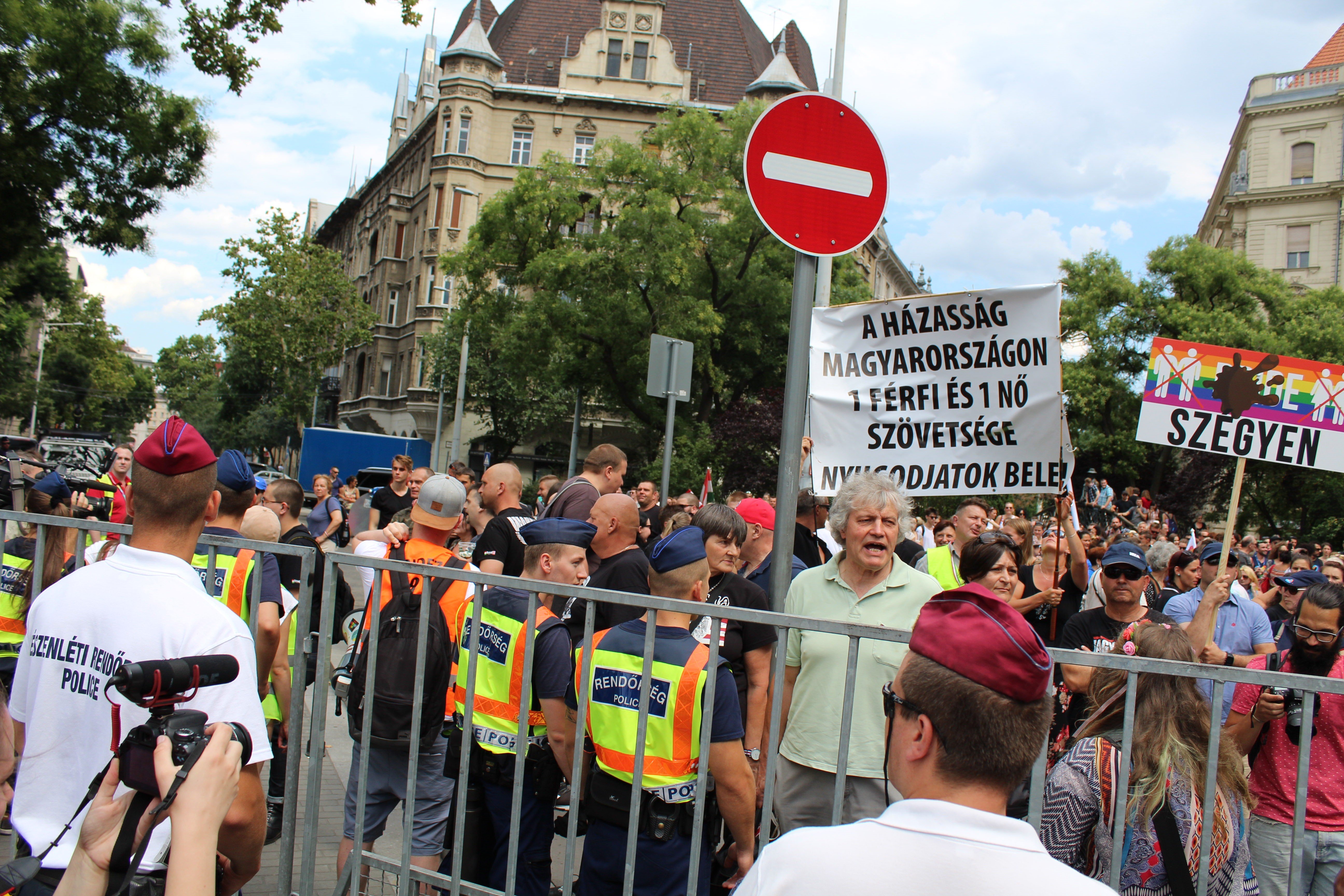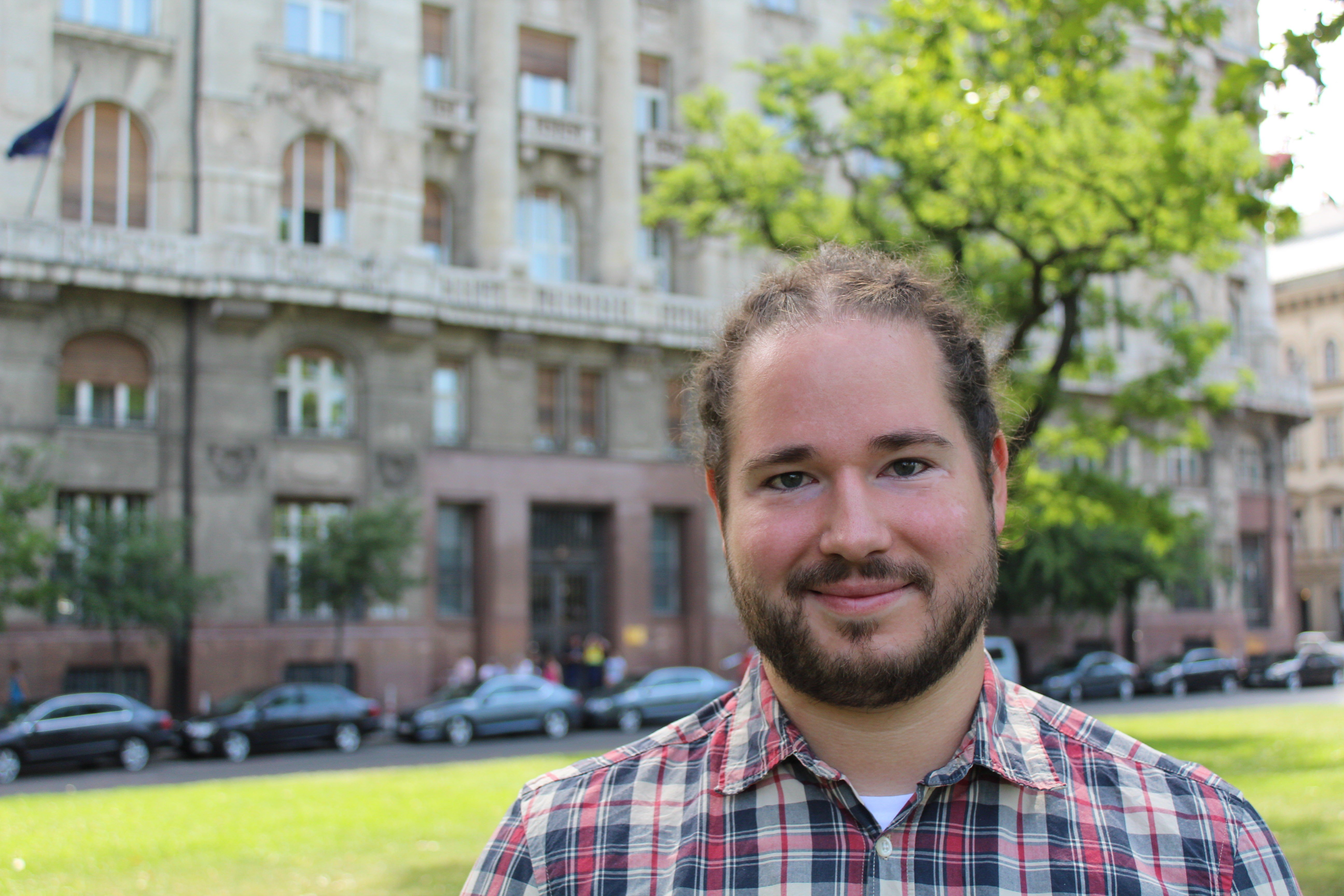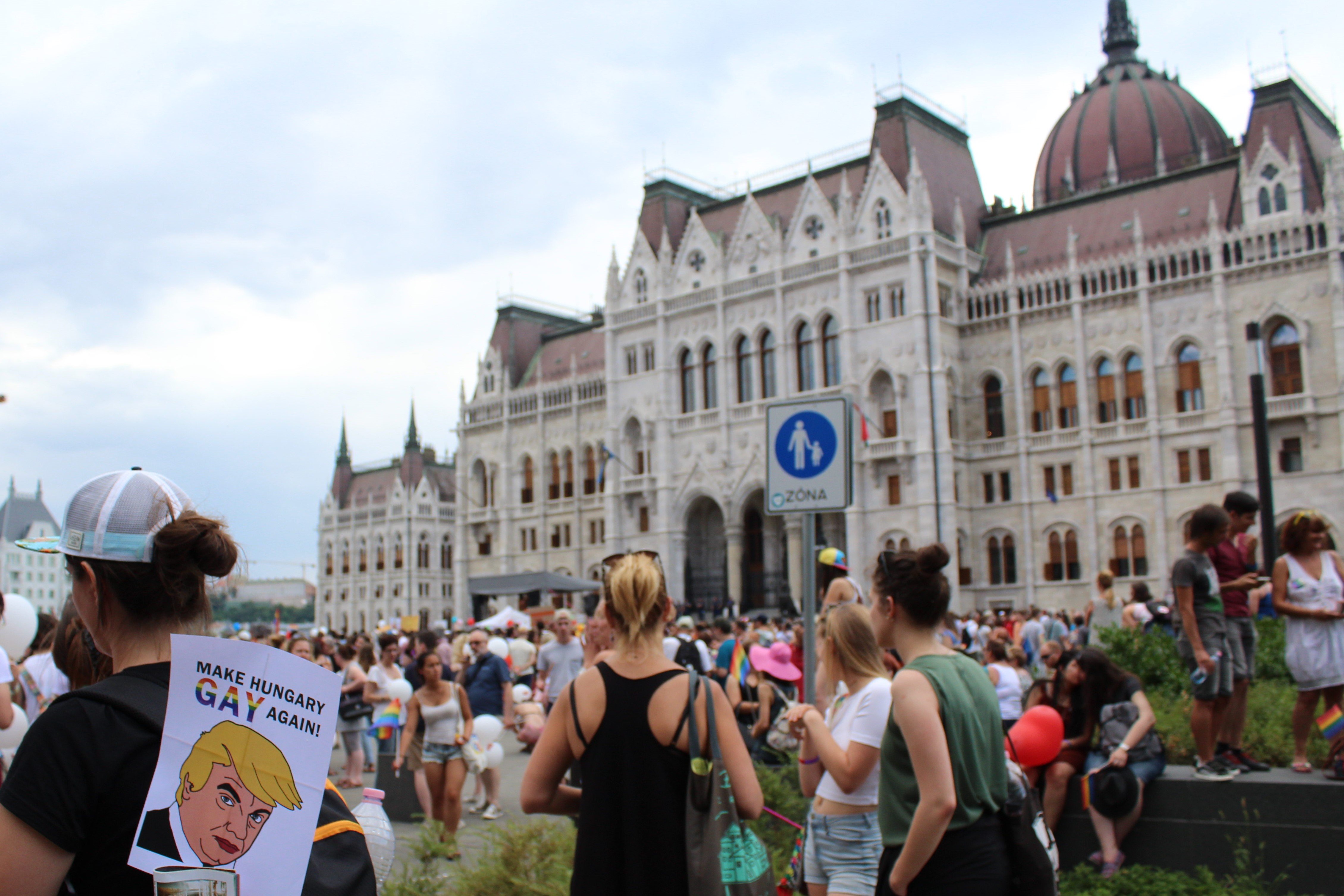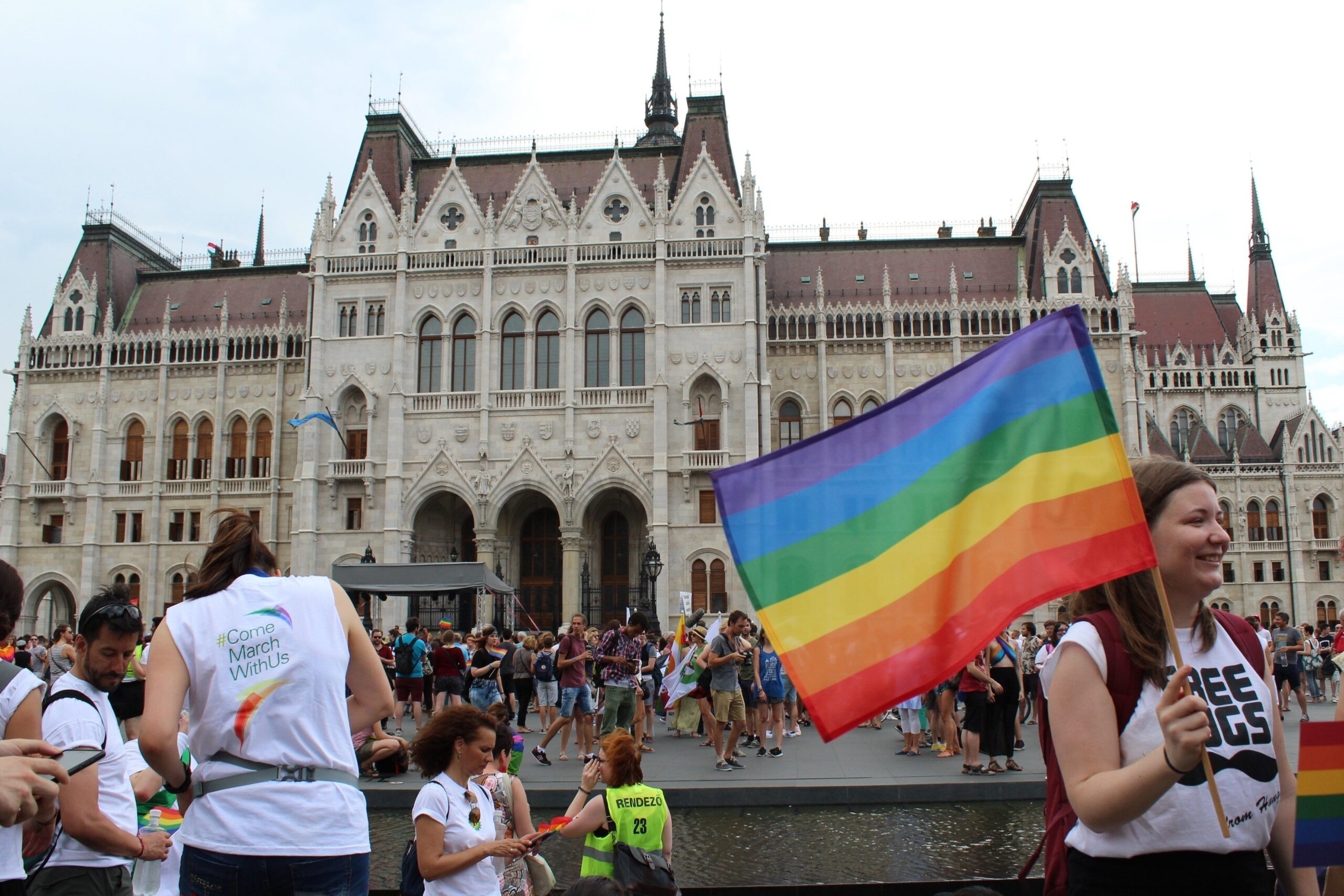About 22,000 marchers in Budapest on July 8, 2017 waved rainbow flags, sashayed in leather and drag, and blasted European dance beats from truck speakers. Only feet away, spectators in the city centre waved and clapped along.
After all, what is a parade with no one to see it?
For some LGBT activists, the simple act of walking alongside the public was a victory. In previous years, marchers say, they had walked down empty streets as police blocked off the route from almost all viewers.
Gay activist Tamás Dombos likens those previous Pride marches to a scene from post-apocalyptic science fiction movies, where the protagonist wanders the streets of an empty city. “Last year, it felt like we were marching in a vacuum,” he says. “The whole point of Pride is visibility and that was not possible at all.”
The fences started in the late 2000s, after a spate of far-right and other anti-gay groups violently attacked the parade in 2007, throwing eggs and rocks at marchers and prompting Amnesty International to question whether police had adequately protected marchers from harm. In 2008 the attacks continued. By 2009, police were cordoning off the parade from streets away, making it more difficult to attack — but also harder to be seen.
Some attacks did still happen over the years, according to reports from human-rights groups. But in the past few years, activists say, the groups of far-right protesters have become smaller and less violent. That led LGBT people to question the need for the level of policing used in more dangerous years.
Organizers have been asking police since as early as 2014 to limit their use of the cordons, but police have repeatedly refused. And while LGBT people have had to seek police protection from physical violence, they’ve also had to fight police for their right to continue the parade. (In 2012, police tried to refuse Pride’s requested parade route, saying that the event would block traffic.)

Several counter protesters gathered outside the rally before the Pride parade, holding anti-gay signs and yelling at participants in July 8, 2017. Credit: Katie Toth/Xtra
“Okay, we can march but only the way the police let us march,” said Viktoria Radvanyi, a Pride organizer who shared her personal frustrations with Xtra two days before the parade. “One [of] our aims is to bridge a divide between the cis hetero community and the LGBTQ community . . . so we really want [spectators] to see Pride.”
This year, Pride changed its planned march only a few hours before the parade began, leaving police without enough time to set up the same barriers as previous years. While some fences and barricades remained, police were sometimes standing only feet between clapping crowds and the people marching down the street.
Police were not impressed. “If the organizer is asking the collaboration of the police to ensure the order of the event, it is the responsibility and the duty of the police to mitigate how they want to provide the conditions of practicing the right of gathering and ensuring the safety of the public,” they wrote in a public statement which has been translated.
However, Budapest Pride spokesperson Dániel Holländer says in an email to Xtra that marching with fewer cordons was an “absolute success.”
“We really hope that this year’s Pride is a great reference for further Budapest Pride marches to come and that we will be able to walk totally free next year,” Holländer says.

Dániel Holländer Pride spokesperson, spoke to media on July 7, 2017 about the importance for Pride participants to be able to march without excessive cordons. Credit: Katie Toth/Xtra
Walking freely in Hungary still means taking some risks. In the middle of the parade, far-right counter-protesters occupied the famous Chain Bridge connecting the east and west sides of the city; police officers cleared the bridge before a confrontation could occur and Pride marched over the Danube River.
The parade also began with a rally near parliament, where about 50 people gathered in counter-protest. At one moment before the rally, several of the counter-protesters broke out into chants of “pedophile geci,” a Hungarian curse word that literally translates to “sperm.”
In an interview with Xtra outside the rally, anti-Pride protester Edda Budaházy said the rise of LGBT rights poses a demographic threat to European nations, which would force European countries to accept immigrants from other countries. “Blacks and Muslims are bombing and killing the White population in Western Europe. This is the truth. And they can’t defend themselves,” she said.
In order to prevent what she perceives as this threat, Budaházy said that Hungarians need to have more children. “The demographic situation is very bad so we need normal families,” she said. “Heterosexual people have a homosexual boy or girl — okay, that’s an accident. But why do we want to reproduce this?”
Budaházy isn’t alone in her views. According to a Budapest Pride study, 56 percent of Hungarians oppose same-sex marriage, and fewer than half of Hungarians support same-sex adoption.
Anti-gay attitudes are also a staple of Hungary’s current political leadership. In 2009, Hungary legalized domestic partnerships. But in June 2017, Hungarian Prime Minister Viktor Orbán welcomed the right-wing World Congress of Families, an annual international conference dedicated to “natural family” values. In 2011, a coalition government under Orbán’s party Fidesz also changed the constitution, legally defining marriage as an institution between a man and a woman.
“A huge part of Fidesz’s politics have been a kind of heteronational system . . . where the threat to the government and the nation is a reproductive threat,” says Hadley Renkin, a gender studies professor and LGBT activist at the Central European University in Budapest.
This worldview is fuelled, Renkin says, by the message that “immigrants and Roma are reproducing too much, unlike ‘real’ Hungarians.” Encouraging more heterosexual families that produce children is a key point in the “preservation of the idea of one ethnic nation.”
LGBT Hungarians, Renkin says, complicate this ideology. “On the one hand they’re officially not reproducing; on the other hand they’re not proper men and women. . . when it comes to LGBT people there’s no place for them except as fear figures in a system to be avoided.”

Crowds gathered in front of Kossuth Lajos tér in front of the Hungarian Parliament before the parade began on July 8, 2017. Credit: Katie Toth/Xtra
Hungary’s governing coalition is also in the midst of an ongoing crackdown against civil society groups, most of them with liberal or progressive leanings. The parliament recently passed a law forcing organizations that receive foreign funding to sign onto a special list, as well as a law against foreign universities that many suspect was aimed at shutting down the liberal Central European University where Renkin teaches.
That means despite the success of the march, Renkin has questions about what it will mean for LGBT human rights in Hungary. “This is a government that doesn’t feel like it has to pay attention to big demonstrations,” he says. Organizers believe the parade had Budapest Pride’s biggest turnout yet: they counted about 2,000 more people than 2016, and more than double its estimated turnout in 2014.
Those numbers may suggest public opinion is shifting, Renkin adds, “but does it change what the government is doing and its heteronational, homophobic politics? I’m not sure.”
Katie Toth is a freelance journalist. She received a tuition scholarship to complete a two-week summer course on media freedom at Central European University in Budapest in July 2017.


 Why you can trust Xtra
Why you can trust Xtra


